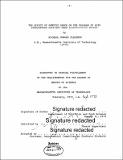The effect of osmotic shock on the release of acid phoshatase activity from streptococcus mutants
Author(s)
Fleisher, Michael Howard.
Download1376529681-MIT.pdf (9.217Mb)
Other Contributors
Massachusetts Institute of Technology. Department of Nutrition and Food Science.
Terms of use
Metadata
Show full item recordAbstract
The "osmotic shock" treatment of bacterial cells has proven to be an effective procedure for releasing hydrolytic enzymes located in the periplasmic compartment of the cell. It was the object of the present study to examine the mechanism of the "osmotic shock" procedure on the Streptococcus mutans strain PR-89 and the measurement of the acid phosphatase activity of the shocked cells. This enzyme could be a primary etiological agent in dental caries formation, and a simple me~hod of releasing-the enzyme would greatly facilitate the characterization of its properties. During the course of the study several important characteristics of the enzyme were observed. First, the enzyme activity increases linearly with the growth of the bacteria. Secondly, in the presence of inorganic phosphate the enzyme is observedly repressed. Finally, during the period of bacterial growth in minimal media supplemented with various concentrations of phosphate, the nature of the enzyme is constituitive. The "osmotic shock" procedure allowed a limited examination of the properties of the acid phosphatase enzyme produced by the Streptococcus mutans. However, the enzyme activity was not successfully separated from the bacterial cell to prove that it had been released.
Description
Thesis: S.M., Massachusetts Institute of Technology, Department of Nutrition and Food Service, 1973 Cataloged from pdf of print version of thesis. "February, 1974, i.e. Sept. 1973." Vita. Includes bibliographical references (pages 46-49).
Date issued
1973Department
Massachusetts Institute of Technology. Department of Nutrition and Food SciencePublisher
Massachusetts Institute of Technology
Keywords
Nutrition and Food Science.